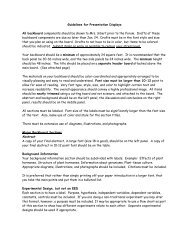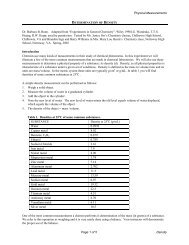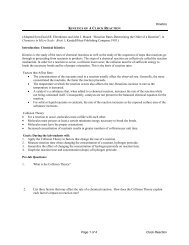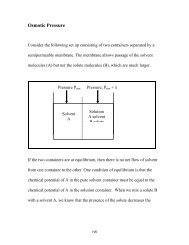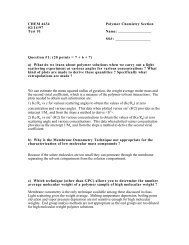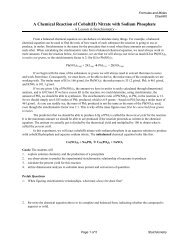Carlier Group Gaussian User Manual - Virginia Tech
Carlier Group Gaussian User Manual - Virginia Tech
Carlier Group Gaussian User Manual - Virginia Tech
You also want an ePaper? Increase the reach of your titles
YUMPU automatically turns print PDFs into web optimized ePapers that Google loves.
<strong>Carlier</strong> <strong>Group</strong> <strong>Gaussian</strong> <strong>User</strong> <strong>Manual</strong> 49<br />
As the table shows, the relative energy at the end of h0462r is -8.2 kcal/mol, very close<br />
to that of the reactant complex (-9.5 kcal/mol). What is wrong with the forward IRC<br />
calculation, where the furthest point is only -37.2 kcal/mol, where as the product<br />
complex is -60.6 kcal/mol? Inspection of the structure shows the C-C bond is fully<br />
formed and the product is in a good conformation. However, in this case the product is<br />
the alkylated enolate and a bromide ion, and the position of the bromide ion plays a<br />
huge role in the energy of the product complex. This is shown by deleting the bromide<br />
from both h0461r2 and h0481, and taking single point energies. In this case we<br />
showed that the organic fragment of h0461r2 was only 2.9 kcal/mol higher in energy<br />
than the organic fragment of the product complex h0481. Thus apparently, movement<br />
of the bromide to it's favored position is not driven by the same forces that move the IRC<br />
from the transition structure towards C-C bond formation.<br />
16. Monitoring IRC Calculations<br />
You must follow what is happening, because failure is common and you don't want to<br />
waste your own (and everyone else's) time. Again, Molden or GaussView3 will provide<br />
the easiest way to monitor these calculations. Visual inspection of geometries and<br />
energies is the key. Note that in Molden all one can assess is how many points have<br />
produced. Points are not the same as steps; a step moves you on the reaction<br />
coordinate a certain amount (governed by stepsize). However after each step is taken<br />
a constrained optimization follows, and this may take or or more points. In Molden if<br />
one looks at geometric convergence you can often see the energy go down in<br />
increments, and the bigger increments most often correspond to these steps. Note<br />
that the first step of an IRC calculation may actually be slightly higher in energy than the<br />
TS. Don't abort the IRC calculation too quickly—give it a chance to see if the energy<br />
starts going down.<br />
Once the number of steps reaches the set maximum the calculation will quit. To see<br />
what step you are on from the command line interface, type<br />
egrep Step filename.out<br />
geometries on the reaction coordinate you have found<br />
egrep Optimized filename.out<br />
In the case of h0461, the IRC calculation terminated normally at the 20 th step, even<br />
though a minimum was not found. Using the egrep commands listed above on<br />
h0461.out you would find 20 steps and 20 optimized geometries.<br />
To see whether the energy is decreasing as desired, the easiest way is to use Molden<br />
or GaussView3. But if you want, you can generate an .xmol file using ircextract2.awk,<br />
and then



